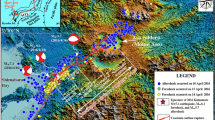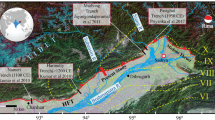Abstract
The Fodongmiao–Hongyazi (FH) fault, which is located on the northern margin of the Qilian Shan, is considered the seismogenic fault of the AD 1609 Hongyazi earthquake. However, the length of the surface rupture remains controversial. As the surface rupture length is an important parameter for understanding earthquake rupture processes and estimating prehistoric earthquake magnitudes, re-evaluating the surface ruptures produced by the 1609 earthquake is necessary. In this study, combining field investigation, satellite imagery interpretation, topographic photogrammetry and 14C dating, we conclude that the rupture extends from Hongyazi village in the east to the Hongshuiba River in the west, with a total length of ~ 90 km. The maximum vertical displacement is 2–3 m, with an average value of 1.3–2 m. The best estimated magnitude is inferred to range between Mw 6.9 and Mw 7.3 based on the empirical relationships between moment magnitude and rupture length, maximum and average displacement. Combining paleoearthquake and slip rate results, we believe that the potential for large earthquakes on the FH fault is low.










Similar content being viewed by others
References
Baltsavias EP, Favey E, Bauder A, Bosch A, Pateraki M (2001) Digital surface modeling by airborne laser scanning and digital photogrammetry for glacier monitoring. Photogramm Rec 17:243–273
Bemis SP, Micklethwaite S, Turner D, Mike RJ, Akciz S, Thiele ST, Bangash HA (2014) Ground-based and UAV-Based photogrammetry: A multi-scale, high-resolution mapping tool for structural geology and paleoseismology. J Struct Geol 69:163–178
Bi HY, Zheng WJ, Zeng JY, Yu HX, Ren ZK (2017) Application of SFM photogrammetry method to the quantitative study of active tectonics. Seismol Geol 39:656–674 (in Chinese with English abstract)
Bronk RC, Higham T, Leach P (2004) Towards high-precision AMS: Progress and limitations. Radiocarbon 46:17–24
Bureau of Geology and Mineral Resources of Gansu Province (1989) Regional Geology of Gansu Province. Geological Publishing House, Beijing 1–692 (in Chinese)
Department of Earthquake Disaster Prevention (1995) The Catalog of Historical Strong Shocks of China (23 BC to 1911 AD). Seismological Press Beijing 1–514 (in Chinese)
Feng X J, Ma J, Zhou Y, England P, Parsons B, Rizza M A, Walker R T (2020) Geomorphology and Paleoseismology of the Weinan fault, Shaanxi, central China, and the source of the 1556 Huaxian earthquake. J Geophys Res: Solid Earth, 125
Gansu Bureau of Geological and Mineral Resources (1973) Geological Map of the Gaotai and Jiuquan Area, Scale 1:200,000. Geological Press Beijing (in Chinese)
Gaudemer Y, Tapponnier P, Meyer B, Peltzer G, Guo SM, Chen ZT, Dai HG, Cifuentes I (1995) Partitioning of crustal slip between linked active faults in the eastern Qilian Shan, and evidence for a major seismic gap, the Tianzhu gap on the western Haiyuan fault, Gansu (China). Geophys J Int 120:599–645
Gu G X (1983) The Catalogue of Earthquakes in China (1831 BC–1969 AD). Science Press Beijing 1–894 (in Chinese)
Harwin S, Lucieer A (2012) Assessing the accuracy of georeferneced point clouds produced via multi-view stereopsis from unmanned aerial vehicle (UAV) imagery. Rem Sensing 4:1573–1599
Hetzel R, Hampel A, Gebbeken P, Xu Q, Gold RD (2019) A constant slip rate for the western Qilian Shan frontal thrust during the last 200 ka consistent with GPS-derived and geological shortening rates. Earth Planet Sci Lett 509:100–113
Hou KM (1998) Characteristics of ground rupture caused by 1927 Gluang M8 earthquake and their causative mechanism. Seismol Geol 20:19–26 (in Chinese with English abstract)
Huang XN, Yang XP, Yang HP (2018) Study on paleoearthquakes along the Fodongmiao-Hongyazi fault, Gansu Province. Seismol Geol 40:753–772 (in Chinese with English abstract)
Institute of Geology and Lanzhou Institute of Seismology (1993) Active Fault Zones in Qilian Mountains and Hexizoulong Regions. Seismological Press Beijing 1–285 (in Chinese)
Javernick L, Brasington J, Caruso B (2014) Modeling the topography of shallow braided rivers using structure from motion photogrammetry. Geomorphology 213:166–182
Jin Q, He WG, Shi ZG, Yuan DY (2011) Paleo-earthquake study on the northern Yumushan active fault. Seismol Geol 33:347–355 (in Chinese with English abstract)
Kim YS, Sanderson DJ (2005) The relationship between displacement and length of faults: A review. Earth Sci Rev 68:317–334
Lanzhou Institute of Seismology (1985) Strong Earthquake Catalog in Shaanxi, Gansu, Ningxia and Qinghai Provinces (1177 BC–1982 AD). Shaanxi Science and Technology Press, 1–170 (in Chinese)
Lei ZS, Yuan DY, Zheng WJ, Ge WP, Liu XW (2012) Textual research of Zhangye-Jiuquan earthquake in 756 A.D. Northwestern Seismol J 34:72–77 (in Chinese with English abstract)
Liu XW, Lei ZS, Yuan DY, Cao N (2011) Textual research on the Hongyapu M7.3 earthquake in 1609. Northwestern Seismol J 33:143–148 (in Chinese with English abstract)
Liu XW, Yuan DY, Zheng WJ, Shao YX, Liu BX, Gao XD (2019) Holocene slip rate of the frontal thrust in the western Qilian Shan, NE Tibetan Plateau. Geophys J Int 219:853–865
Liu XW, Yuan DY, He WG (2014) Preliminary Study of Palaeo-earthquakes on the Fodongmiao-Hongyazi Fault in the North Margin of Qilian Mountain. Technology for Earthquake Disaster Prevention 9:411–419 (in Chinese with English abstract)
Mancini F, Dubbini M, Gattelli M, Stecchi F, Fabbri S, Giovanni G (2013) Using unmanned aerial vehicles (UAV) for high resolution reconstruction of topography: the structure from motion approach on coastal environments. Rem Sens 5:6880–6898
McCalpin JP (2009) Paleseismology. 2nd edition. Academic Press Amsterdam London 1–615
Meyer B, Tapponnier P, Bourjot L, Metivier F, Gaudemer Y, Peltzer G, Guo SM, Chen ZT (1998) Crustal Thickening in Gansu-Qinghai, Lithospheric Mantle Subduction, and Oblique, Strike-Slip Controlled Growth of the Tibet Plateau. Geophys J Int 135:1–47
Middleton TA, Walker RT, Parsons B, Lei QY, Zhou Y, Ren ZK (2016) A major, intraplate, normal-faulting earthquake: The 1739 Yinchuan event in northern China. J Geophys Res Solid Earth 121:293–320
Peltzer G, Tapponnier P, Gaudemer Y, Meyer B, Guo SM, Yin K, Chen ZT, Dai HG (1988) Offsets of late Quaternary morphology, rate of slip and recurrence of large earthquakes on the Changma fault (Gansu, China). J Geophys Res 93:7793–7812
Reimer PJ, Bard E, Bayliss A, Van der Plicht J (2013) IntCal13 and Marine13 radiocarbon age calibration curves 0–50,000 years cal BP. Radiocarbon 55:1869–1887
Ren ZK, Zhang ZQ (2019) Structural analysis of the 1997 Mw 7.5 Manyi earthquake and the kinematics of the Manyi fault, central Tibetan Plateau. J Asian Earth Sci 179:149–164
Ren ZK, Zielke O, Yu JX (2018) Active tectonics in 4D high-resolution. J Struct Geol 117:267–271
Schwartz DP, Coppersmith KJ (1984) Fault behavior and characteristic earthquakes-Examples from the Wasatch and San Andreas Fault zones. J Geophys Res 89:5681–5698
Shao YX, Yuan DY, Oskin ME, Wang PT, Liu-Zeng J, Li CP, Wu Z (2017) Historical (Yuan Dynasty) Earthquake on the North Danghe Nanshan Thrust, Western Qilian Shan, China. Bull Seismol Soc Am 107:1175–1184
Tapponnier P, Meyer B, Avouac JP, Peltzer Y, Gaudemer Y, Guo SM, Xiang HF, Yin K, Chen ZT, Cai SH, Dai HG (1990) Active thrusting and folding in the Qilian and decoupling between upper crust and mantle in the northeast Tibet. Earth Planet Sci Lett 97:382–403
Tapponnier P, Xu ZQ, Roger F, Meyer B, Arnaud N, Wittlinger G, Yang JS (2001) Oblique stepwise rise and growth of the Tibet plateau. Science 294:1671–1677
Ullman S (1979) The interpretation of structure from motion. Proc R Soc Lond B Biol 203:405–426
University of Oxford (2017) OxCal/ORAU. https://c14.arch.ox.ac.uk/login/login.php?Location=/oxcal/OxCal.html, https://foreignnationals-thamesvalleypolice.uk/Home
Wallace RE (1970) Earthquake recurrence interval on the San Andreas Fault. Geol Soc Am Bull 81:2875–2890
Wells DL, Coppersmith KJ (1994) New empirical relationships among magnitude, rupture length, rupture width, rupture area, and surface displacement. Geol Soc Am Bull 84:974–1002
Xiong JG, Li YL, Zhong YZ, Lv HH, Lei JH, Xin WL, Wang LB, Hu X, Zhang PZ (2017) Latest Pleistocene to Holocene thrusting recorded by a flight of strath terraces in the eastern Qilian Shan, NE Tibetan Plateau. Tectonics 36:2972–2986
Xu XW, Yeats RS, Yu GH (2010) Five short historical earthquake surface ruptures near the Silk Road, Gansu Province, China. Bull Seismol Soc Am 100:541–561
Xu XW, Chen GH, Yu GH, Cheng J, Tan XB, Zhu AL, Wen XZ (2013) Seismogenic structure of Lushan earthquake and its relationship with Wenchuan earthquake. Earth Scie Frontiers 20:11–20 (in Chinese with English abstract)
Xu YR, He HL, Deng QD, Allen MB, Sun HY, Bi LS (2018) The CE 1303 Hongdong earthquake and the Huoshan Piedmont Fault, Shanxi Graben: Implications for magnitude limits of normal fault earthquakes. J Geophys Res: Solid Earth 123:3098–3121
Yang HB, Yang XP, Huang XN, Hu ZK (2018) Late Quaternary tectonic deformation around the Hujiatai anticline alogn the east segment of the Fodongmiao-Hongyazi fault, northern Qilian Shan: an insight on the seismogenic pattern of 1609 Hongyazi M7.3 earthquak. Seismol Geol 40:980–998 (in Chinese with English abstract)
Yang S F, Chen H L, Cheng X G, Xiao A C, Chen J J, Fan M T, Tian M T (2007) The structural characteristics of Northern Qilian Shan Mountain Thrust Belt and its control on the oil and gas accumulation. Science Press Beijing 1–159 (in Chinese)
Yeats R S, Sieh K E, Allen C R, Geist E (1997) The Geology of Earthquakes. Oxford University Press 1- 568
Yu JX, Zheng WJ, Kirby E, Zhang PZ, Lei QY, Ge WP, Wang WT, Li XN, Zhang N (2016) Kinematics of late Quaternary slip along the Yabrai fault: Implications for Cenozoic tectonics across the Gobi Alashan block, China. Lithosphere 8:199–218
Yuan DY, Ge WP, Chen ZW, Li CY, Wang ZC, Zhang HP, Zhang PZ, Zheng DW, Zheng W, J, Craddock WH, (2013) The growth of northeastern Tibet and its relevance to large-scale continental geodynamics: A review of recent studies. Tectonics 32:1358–1370
Zhang PZ, Wen XZ, Shen ZK, Chen JH (2010) Oblique, high-angle, listric reverse faulting and associated development of strain: the Wenchuan earthquake of May 12, 2008, Sichuan, China. Annu Rev Earth Pl Sci 38:353–382
Zheng DW, Clark MK, Zhang PZ, Zheng WJ, Farley KA (2010) Erosion, fault initiation and topographic growth of the North Qilian Shan (northern Tibetan Plateau). Geosphere 6:937–941
Zheng W J (2009) Geometric pattern and active tectonics of the Hexi Corridor and its adjacent regions. Dissertation, Institute of Geology, China Earthquake Administration, 1–209 (in Chinese with English abstract)
Zheng WJ, Zhang PZ, Ge WP, Molnar P, Zhang HP, Yuan DY, Liu JH (2013) Late Quaternary Slip Rate of the South Heli Shan Fault (northern Hexi Corridor, NW China) and Its Implications for Northeastward Growth of the Tibetan Plateau. Tectonics 32:271–293
Zuza AV, Cheng X, Yin A (2016) Testing models of Tibetan Plateau formation with Cenozoic shortening estimates across the Qilian Shan-Nan Shan thrust belt. Geosphere 12:501–532
Acknowledgements
We thank Austin Elliott and Barry Parsons for providing constructive suggestions in the field investigation. This work was jointly supported by the by the Second Tibetan Plateau Scientific Expedition and Research Program (2019QZKK0901) and National Science Foundation of China (42072246).
Author information
Authors and Affiliations
Corresponding author
Additional information
Responsible Editor: Longjun Dong
Rights and permissions
About this article
Cite this article
Liu, Xw., Yuan, Dy., Shao, Y. et al. Re-evaluation of Surface Ruptures Produced by the 1609 M 7.3 Hongyazi Earthquake in the Northern Qilian Shan, China. Arab J Geosci 15, 542 (2022). https://doi.org/10.1007/s12517-021-08633-8
Received:
Accepted:
Published:
DOI: https://doi.org/10.1007/s12517-021-08633-8




